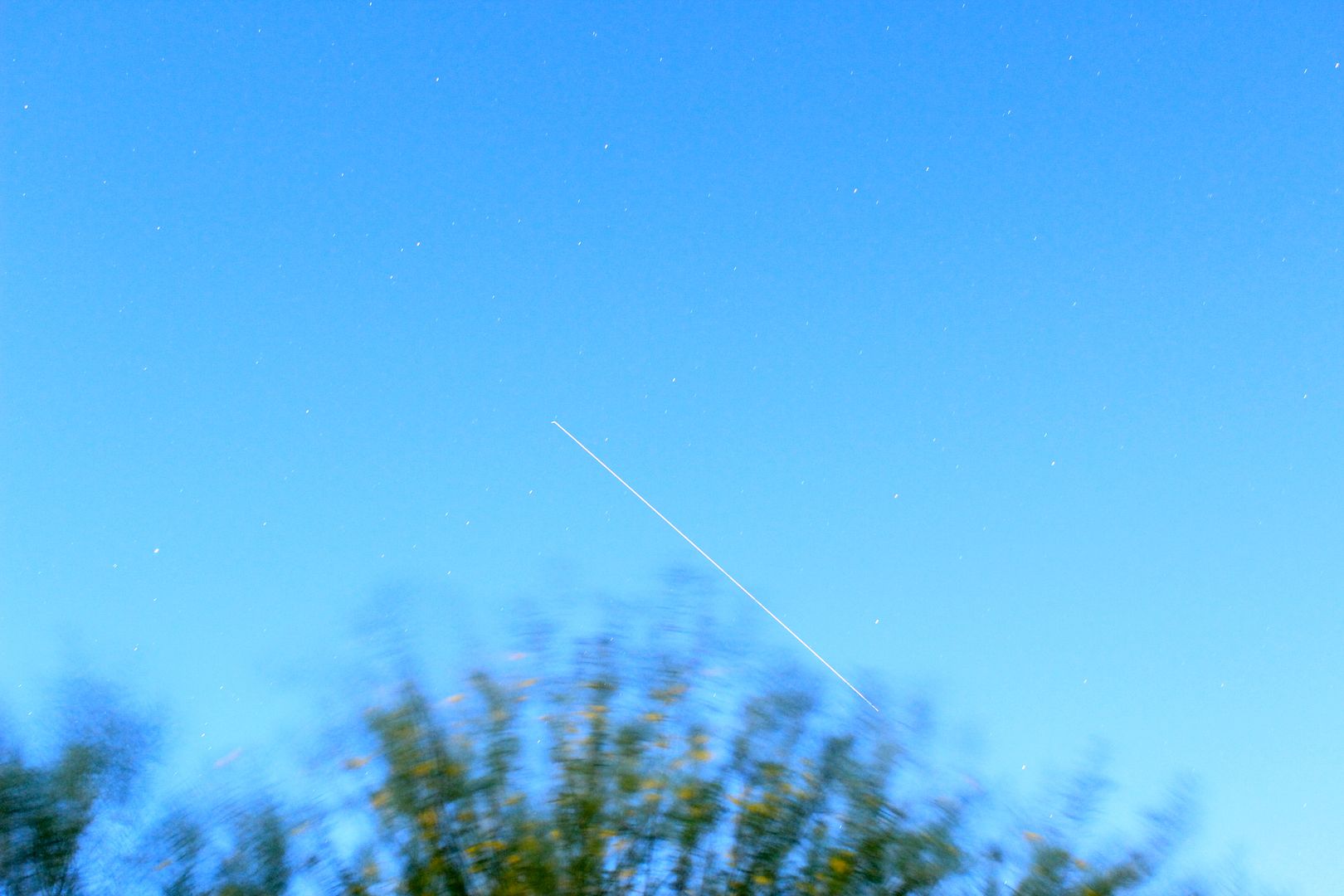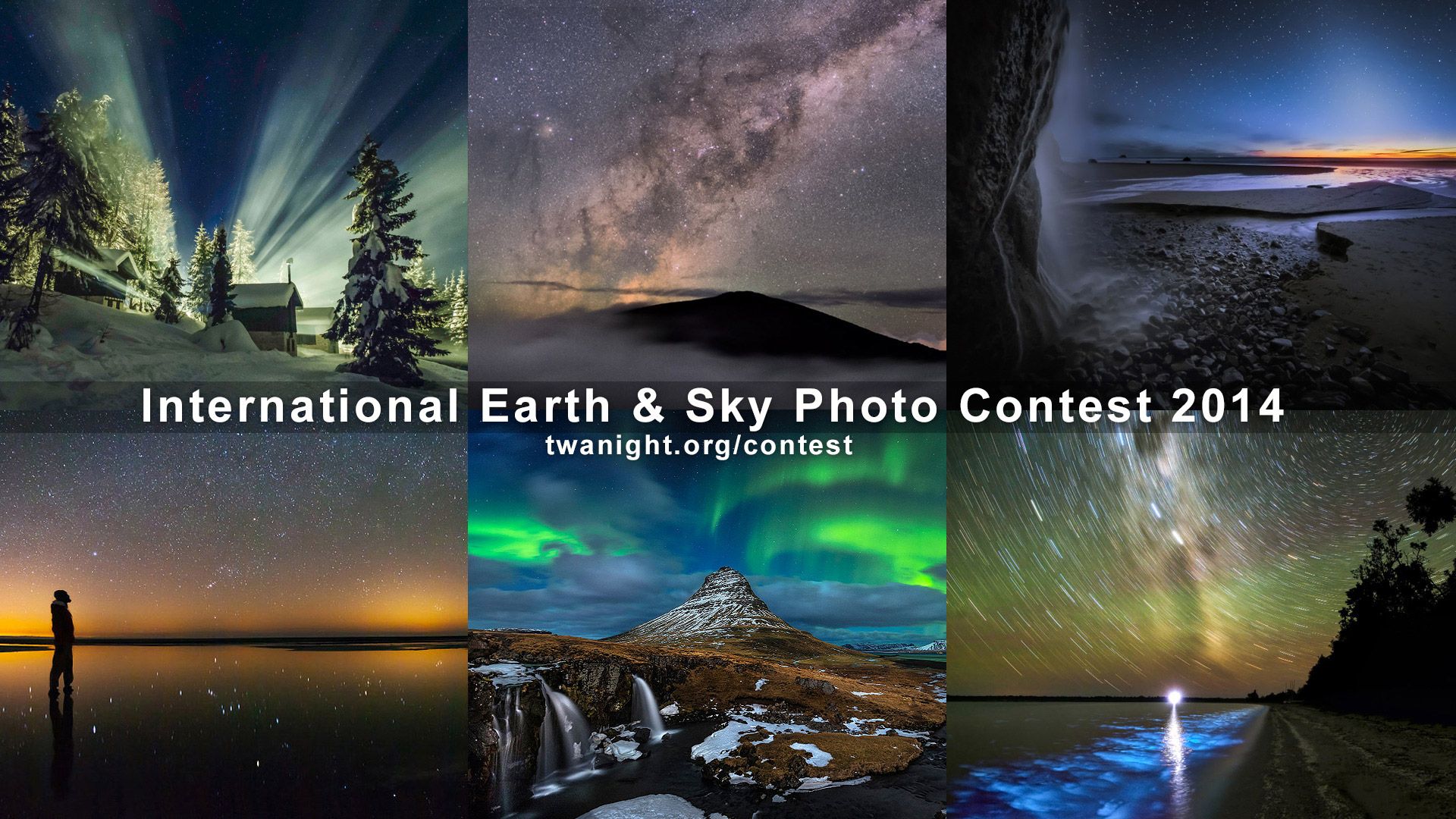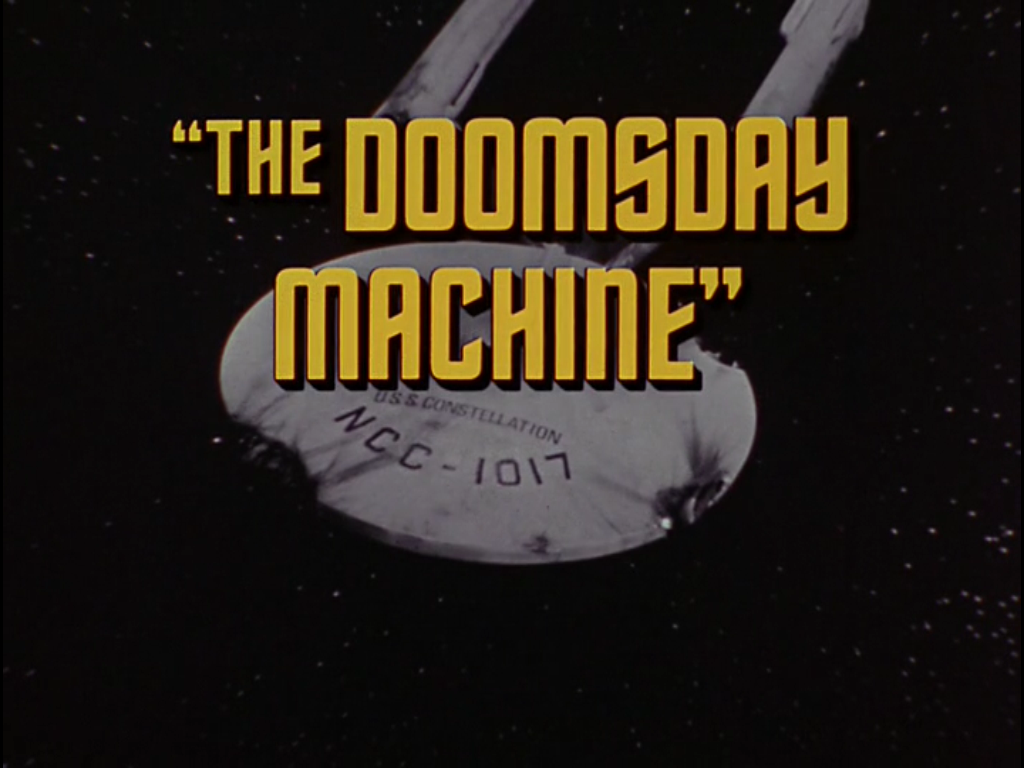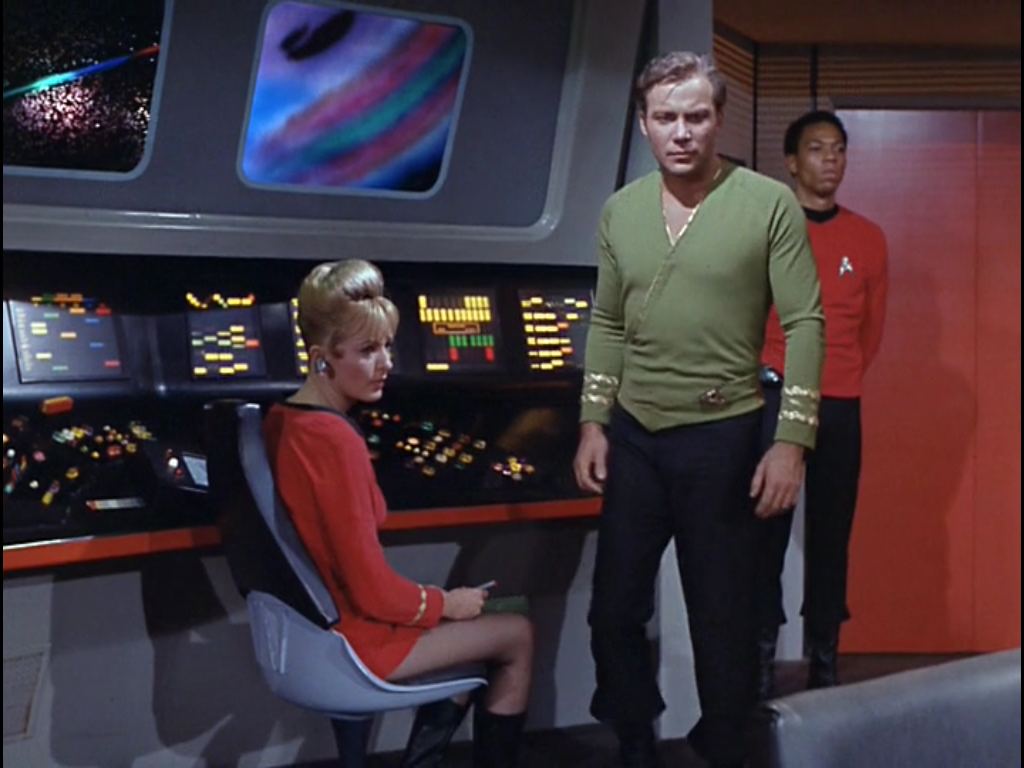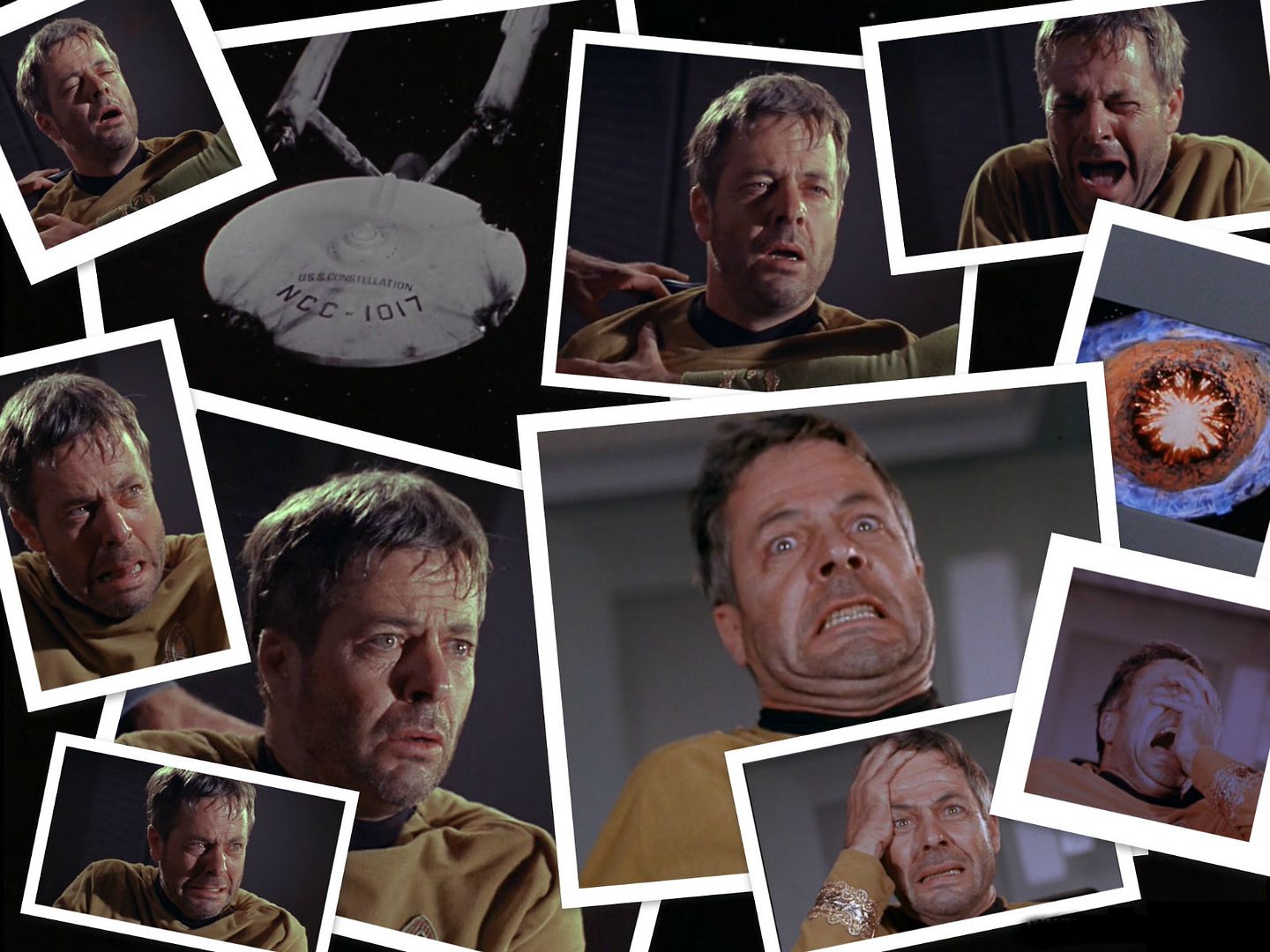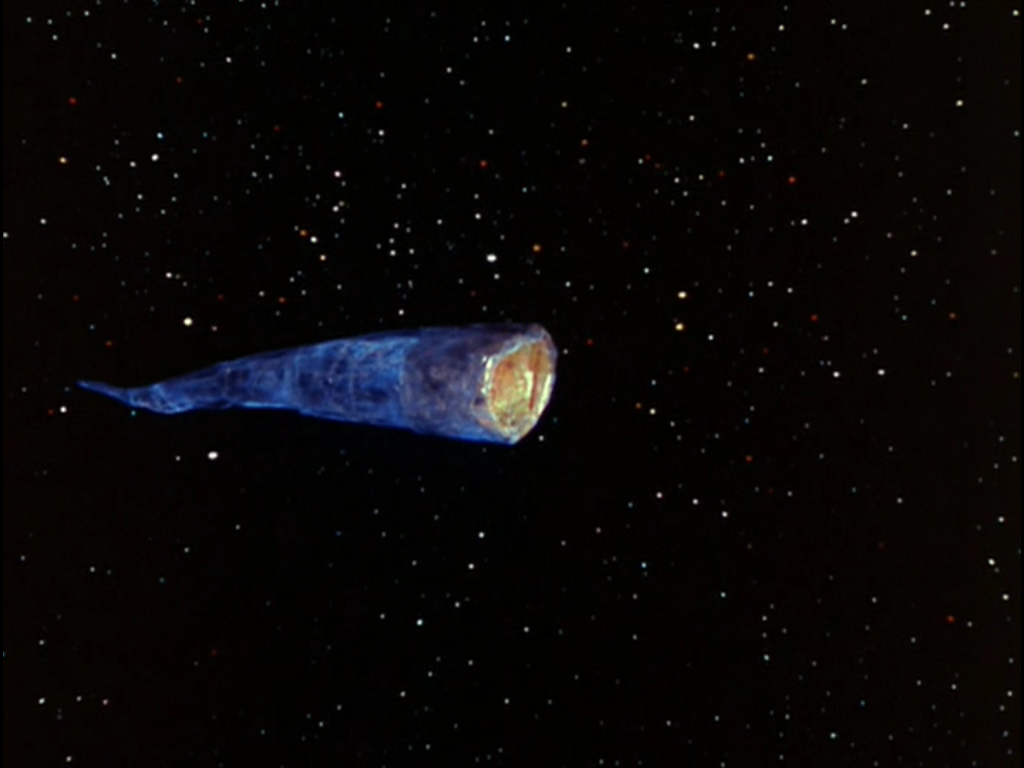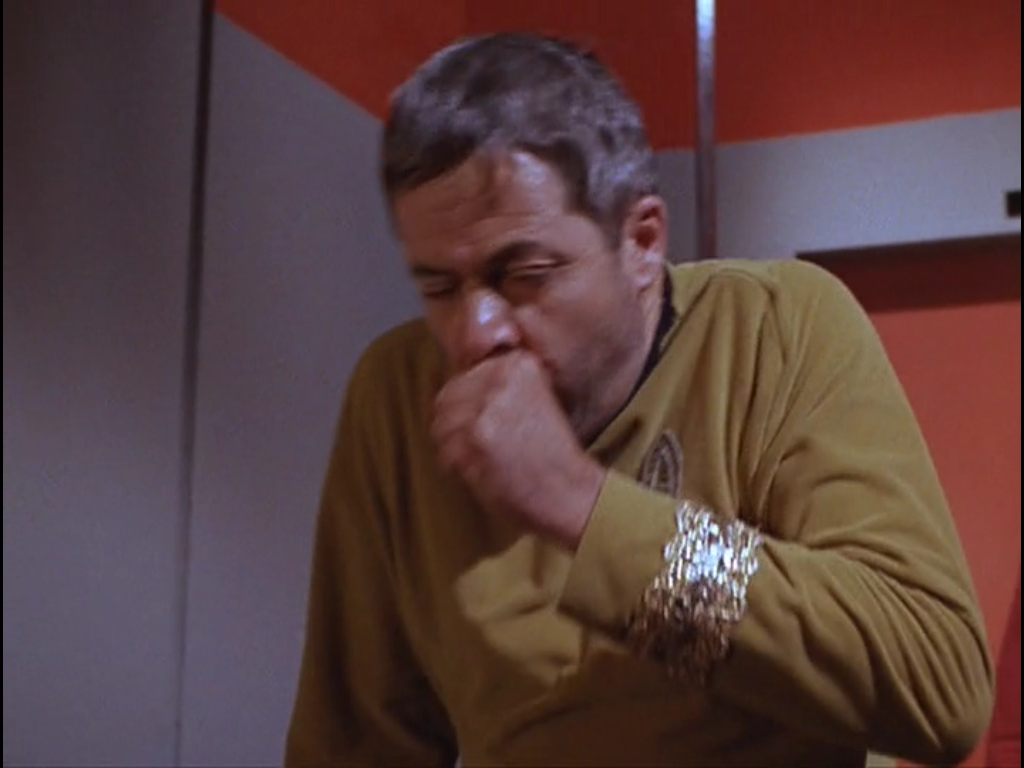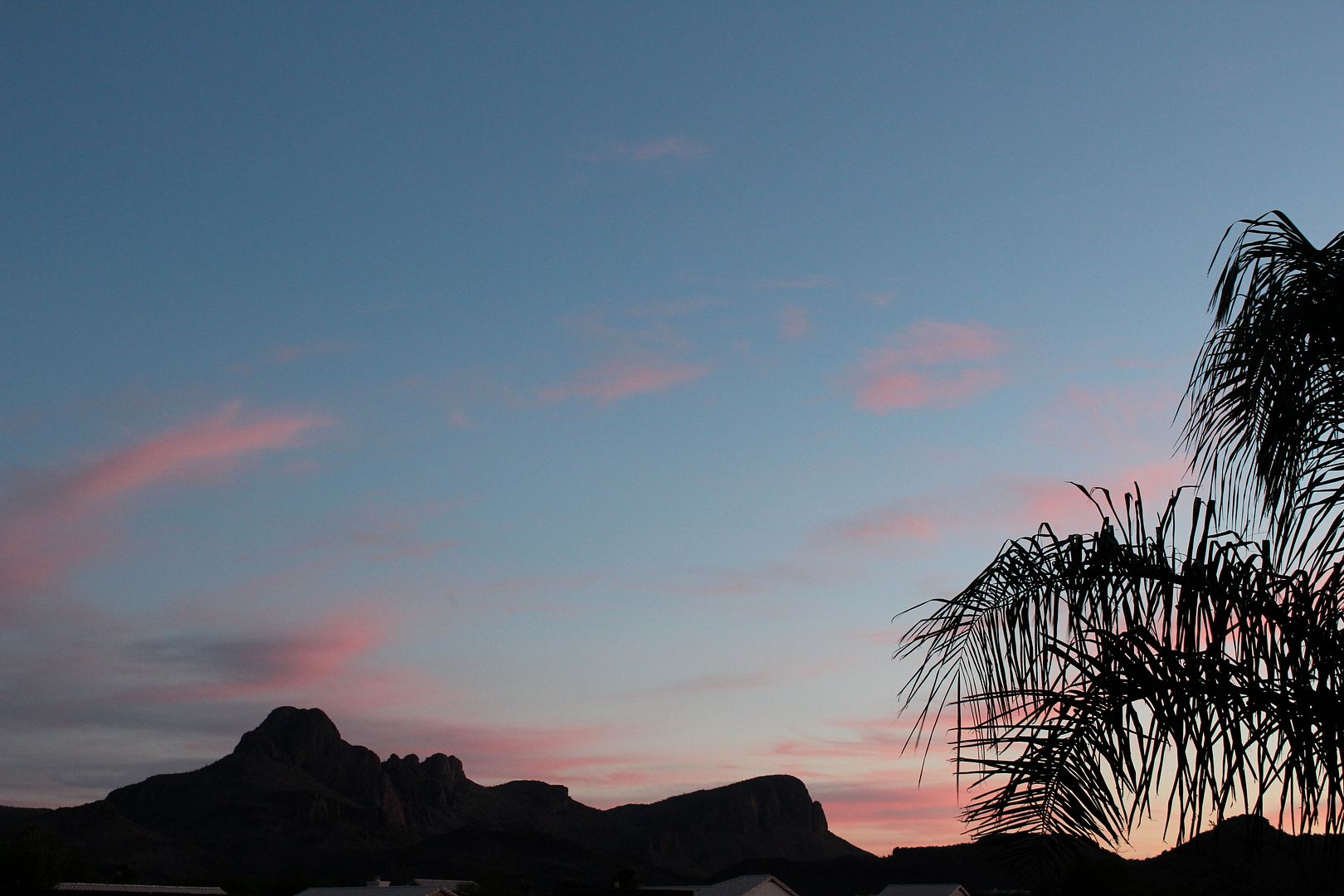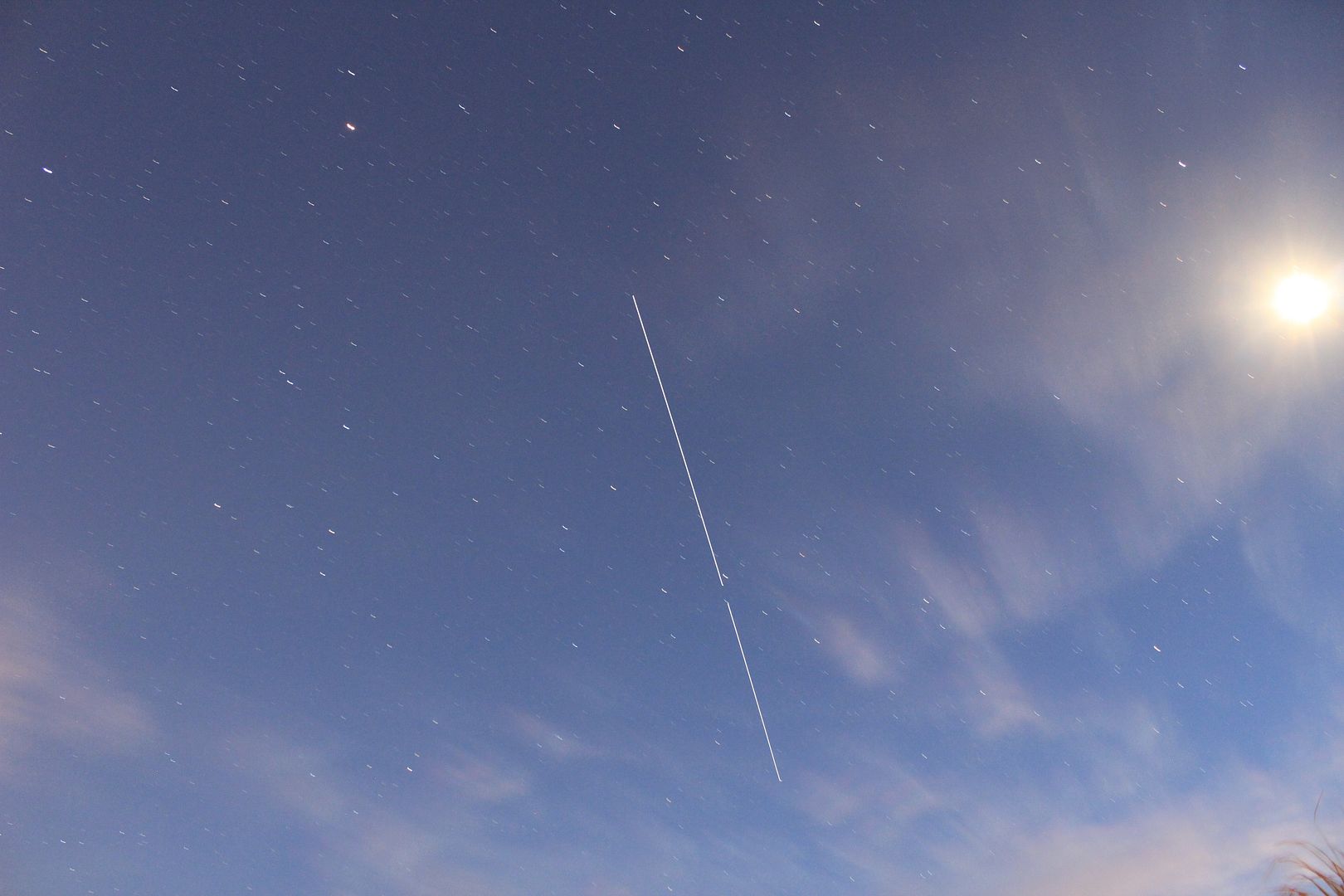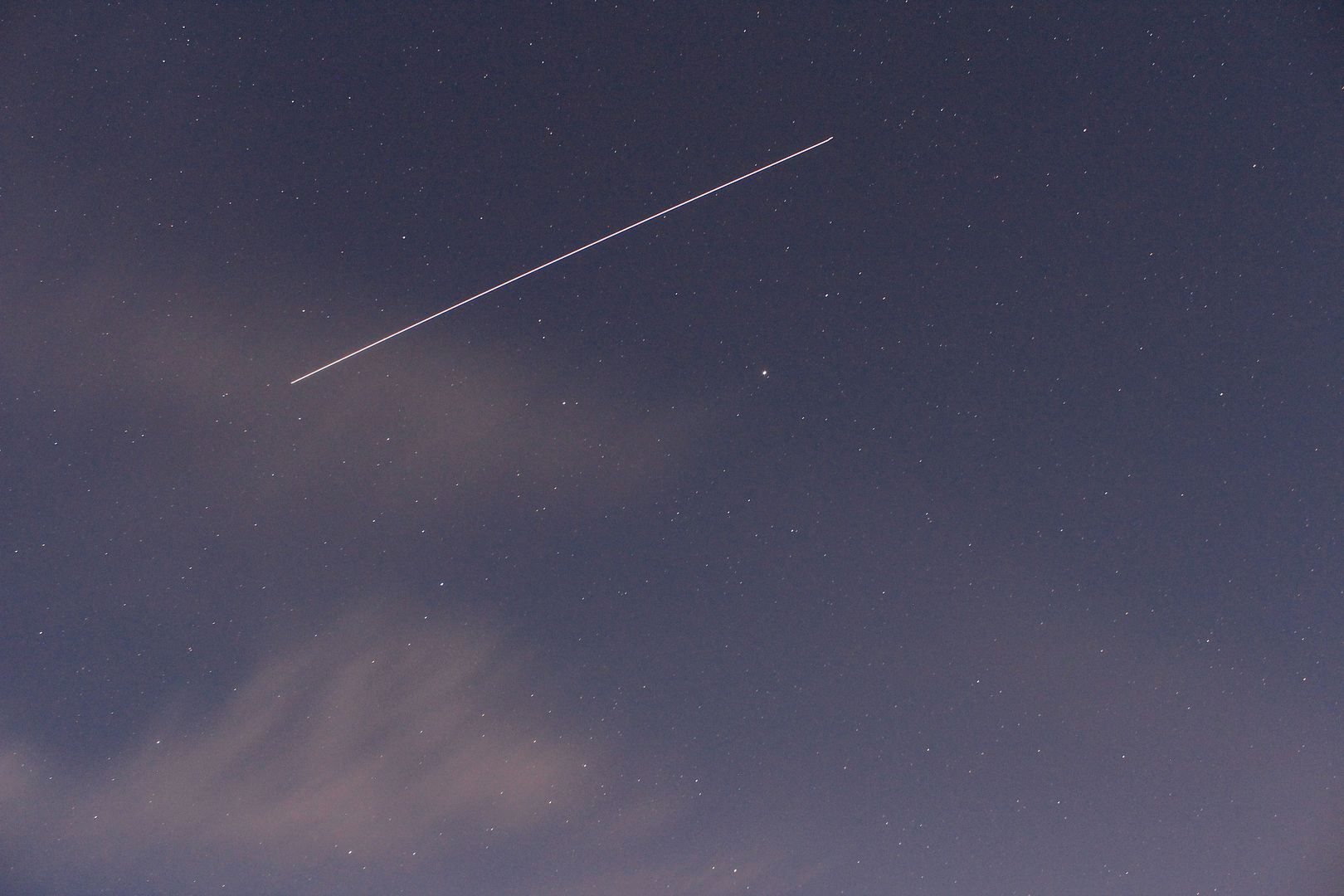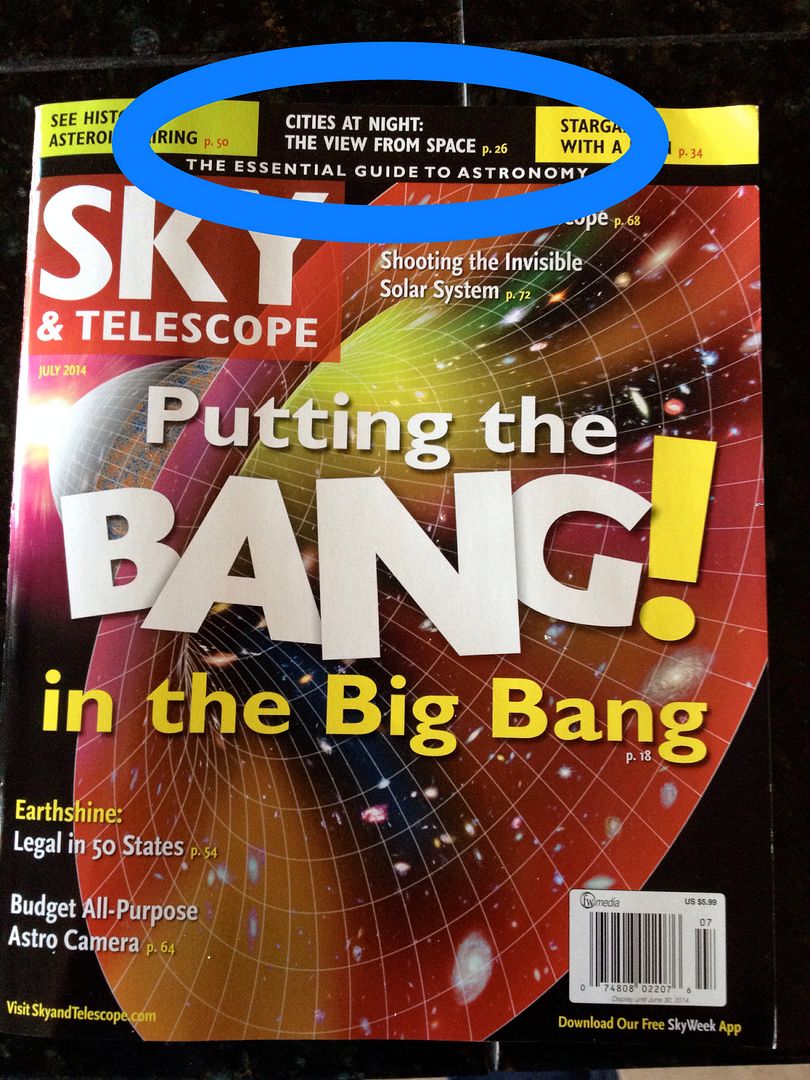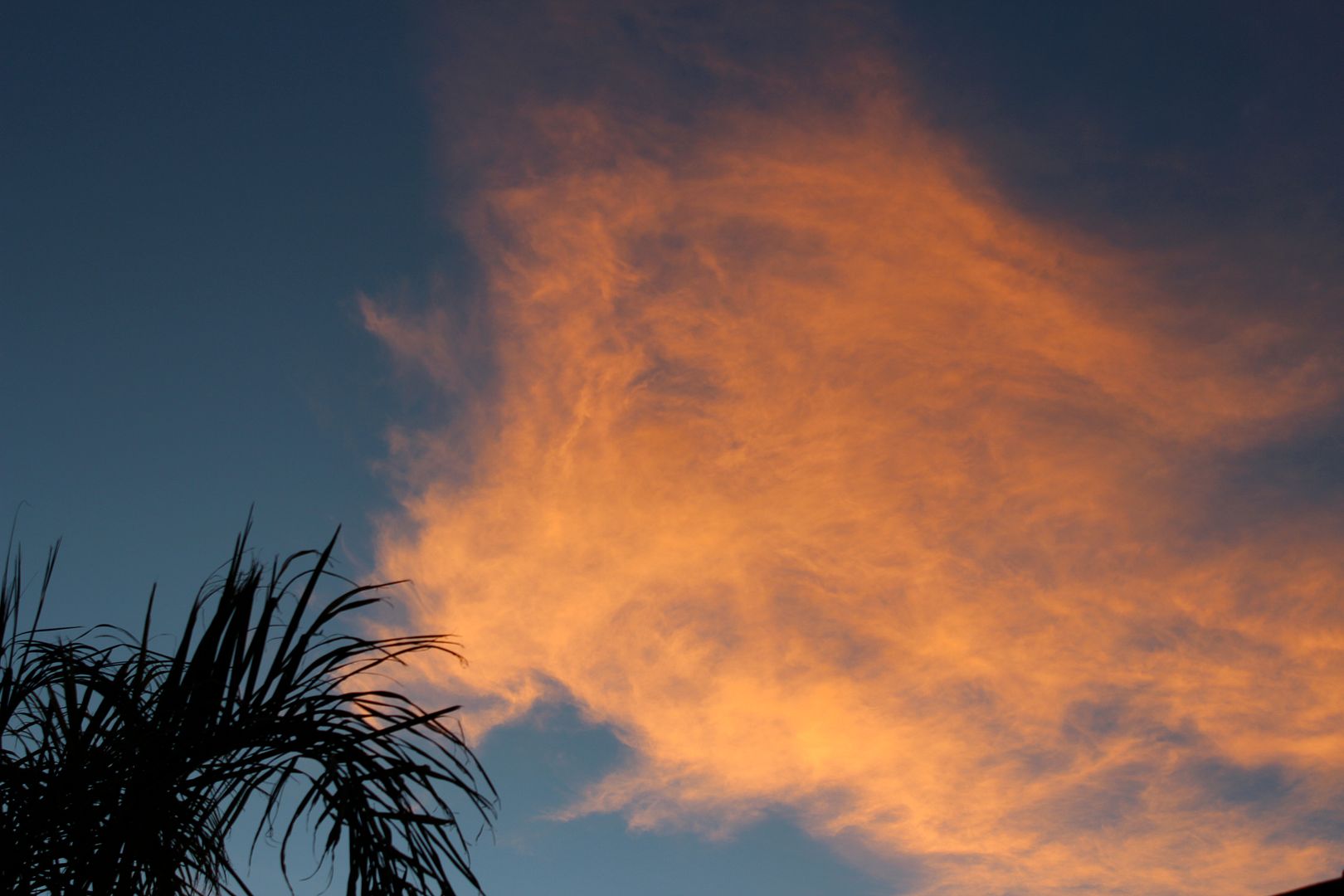No story, just a couple of shots of some quail from this afternoon:
Sunday, June 29, 2014
Saturday, June 28, 2014
This Evening's Bat Moon
It is nice to watch the bats beginning their night silhouetted against the twilight sky. It is even nicer catching one with a thin, crescent moon.
Monday, June 23, 2014
Space Station in Twilight
Sunday, June 22, 2014
The Colors of Light
Most of us don't pay too much attention to lighting. Beyond how a light fixture looks, usually in the daytime, there isn't too much thought given to how well it actually does with what it is supposed to do - provide illumination.
There are several important factors that should always be considered for both interior and exterior lighting beyond just aesthetics. Certainly the total amount of light and where that light shines are important considerations, especially outdoors. Using too much light, especially light that is poorly directed, can lead to excessive light pollution. It turns out that the color (Well, the spectrum really. More on that below.) of light is equally important in preserving the night sky.
It may surprise some to know that the color of light is important for interior lighting too.
Here's a light fixture with two different CFL bulbs in it. There's a pretty dramatic color difference between the two of them. The one on the left is blue-white in color, while the one on the right has a warmer hue to it.
Most light sources are not pure, single colors, but rather are a mix of different colors. Recall that ordinary sunlight is a mix of colors too. Nature splits them into their components forming a rainbow.
By passing the light of the bulbs above through a spectroscope we can analyze the colors in greater detail:
That's the spectrum of the blueish looking CFL bulb on the left and the warmer one on the right. The graphs show how much of each color there is shining out from each bulb. Blue, green and yellow-orange dominate the mix of the bulb that looks blue-white, while green and yellow-orange dominate from the warmer blub on the right.
Okay, "so what?", you might ask. First off, most people have preference for warmer light sources like the one on the right. Recall (if you're old enough), that when CFL bulbs were first introduced many people complained about how cold and harsh they looked. Those early CFLs were much like the bulb on the left. But it's more than that. In 2010 the International Dark-Sky Association (full disclosure: I work for them) published a paper providing warnings about blue-rich light and how it can cause problems for both interior and exterior use (See also IDA's "Seeing Blue" article here).
The physics of the situation says that any blue light that ends up in the sky, from poorly directed light or even reflection off of the ground, disproportionately brightens the night sky more than any other color. But for interior use, like the CFL bulbs shown here, there are problems too.
It turns out that blue light is an important marker for our internal clocks. Why would that be? Nature has given us an important indicator that tells our bodies when it is daytime - the blue sky.
Here's the spectrum of the daytime sky. No surprise here, it is really blue. Evolution has given us photoreceptors beyond the more familiar cones and rods of the eye that don't contribute to our vision. Instead, they are tuned to blue light, giving our bodies the cues to keep our internal clocks in synch.
That's why it is important to limit the amount of blue light you are exposed to at night. Blue light from CFL bulbs, screens from TVs, smartphones and more can help throw our systems out of whack, leading to sleep disorders and even long term medical problems.
When choosing bulbs be sure to look at the color temperature (CCT) on the packaging. It will use words like "warm white" or "cool white," but you'll also see a number in the Kelvin temperature scale. For the CFL bulbs here, the blue one has a CCT of 5000K and the warm one is 2500K. Generally speaking, lower numbers have less blue light in them.
To help limit my blue light exposure at home I have low CCT bulbs in the house. I also I use the program f.lux for my laptop. It adjusts the color temperature based on the time of day, dropping my display down to 2700K at night.
The Times, They are a Changin'
We're going through a lighting revolution right now as new technologies are appearing. LEDs (Light Emitting Diodes) are becoming affordable and are showing up for inside and outside applications. The spectrum of an LED light source bears little resemblance to that of a CFL, which isn't too surprising as the light is created differently.
Here are the spectra of two different LED lamps. The CCT of the one on the left is 5800K while the one on the right is 2800K. Notice that both of them have a spike of blue light, but it is much smaller in the 2800K light source. For LEDs used inside it is really important to go with the warmer (lower number CCT) sources so as to not disrupt your internal clock.
It is also important to go with warmer choices for outside lighting, but for different reasons.
More and more cities are making the conversion to LED streetlights. It is a concern because, while generally speaking these new LED streetlights are shielded (downward pointing), the cities sometimes end up choosing lights with excessive amounts of blue and, as I said above, blue light disproportionately brightens the night sky more than the other colors do. So if not done properly, a conversion to LED could lead to brighter skies - something those of us interested in astronomy will want to avoid.
I'll be blogging more about LEDs in a future post.
There are several important factors that should always be considered for both interior and exterior lighting beyond just aesthetics. Certainly the total amount of light and where that light shines are important considerations, especially outdoors. Using too much light, especially light that is poorly directed, can lead to excessive light pollution. It turns out that the color (Well, the spectrum really. More on that below.) of light is equally important in preserving the night sky.
It may surprise some to know that the color of light is important for interior lighting too.
Here's a light fixture with two different CFL bulbs in it. There's a pretty dramatic color difference between the two of them. The one on the left is blue-white in color, while the one on the right has a warmer hue to it.
Most light sources are not pure, single colors, but rather are a mix of different colors. Recall that ordinary sunlight is a mix of colors too. Nature splits them into their components forming a rainbow.
By passing the light of the bulbs above through a spectroscope we can analyze the colors in greater detail:
That's the spectrum of the blueish looking CFL bulb on the left and the warmer one on the right. The graphs show how much of each color there is shining out from each bulb. Blue, green and yellow-orange dominate the mix of the bulb that looks blue-white, while green and yellow-orange dominate from the warmer blub on the right.
Okay, "so what?", you might ask. First off, most people have preference for warmer light sources like the one on the right. Recall (if you're old enough), that when CFL bulbs were first introduced many people complained about how cold and harsh they looked. Those early CFLs were much like the bulb on the left. But it's more than that. In 2010 the International Dark-Sky Association (full disclosure: I work for them) published a paper providing warnings about blue-rich light and how it can cause problems for both interior and exterior use (See also IDA's "Seeing Blue" article here).
The physics of the situation says that any blue light that ends up in the sky, from poorly directed light or even reflection off of the ground, disproportionately brightens the night sky more than any other color. But for interior use, like the CFL bulbs shown here, there are problems too.
It turns out that blue light is an important marker for our internal clocks. Why would that be? Nature has given us an important indicator that tells our bodies when it is daytime - the blue sky.
Here's the spectrum of the daytime sky. No surprise here, it is really blue. Evolution has given us photoreceptors beyond the more familiar cones and rods of the eye that don't contribute to our vision. Instead, they are tuned to blue light, giving our bodies the cues to keep our internal clocks in synch.
That's why it is important to limit the amount of blue light you are exposed to at night. Blue light from CFL bulbs, screens from TVs, smartphones and more can help throw our systems out of whack, leading to sleep disorders and even long term medical problems.
When choosing bulbs be sure to look at the color temperature (CCT) on the packaging. It will use words like "warm white" or "cool white," but you'll also see a number in the Kelvin temperature scale. For the CFL bulbs here, the blue one has a CCT of 5000K and the warm one is 2500K. Generally speaking, lower numbers have less blue light in them.
To help limit my blue light exposure at home I have low CCT bulbs in the house. I also I use the program f.lux for my laptop. It adjusts the color temperature based on the time of day, dropping my display down to 2700K at night.
The Times, They are a Changin'
We're going through a lighting revolution right now as new technologies are appearing. LEDs (Light Emitting Diodes) are becoming affordable and are showing up for inside and outside applications. The spectrum of an LED light source bears little resemblance to that of a CFL, which isn't too surprising as the light is created differently.
Here are the spectra of two different LED lamps. The CCT of the one on the left is 5800K while the one on the right is 2800K. Notice that both of them have a spike of blue light, but it is much smaller in the 2800K light source. For LEDs used inside it is really important to go with the warmer (lower number CCT) sources so as to not disrupt your internal clock.
It is also important to go with warmer choices for outside lighting, but for different reasons.
More and more cities are making the conversion to LED streetlights. It is a concern because, while generally speaking these new LED streetlights are shielded (downward pointing), the cities sometimes end up choosing lights with excessive amounts of blue and, as I said above, blue light disproportionately brightens the night sky more than the other colors do. So if not done properly, a conversion to LED could lead to brighter skies - something those of us interested in astronomy will want to avoid.
I'll be blogging more about LEDs in a future post.
Wednesday, June 18, 2014
2014 International Earth & Sky Photo Contest Winners
The results are in and the winners of the 2014 International Earth & Sky Photo Contest have been announced.
This was the 5th annual contest and once again it has produced an amazing array of images that capture the beauty of the night and the importance of preserving dark skies.
Contest organizer Babak Tafreshi has produced a video of the winning pics, which is embedded here:
Follow the link to see and learn more about all the winners of at The World At Night website.
This was the 5th annual contest and once again it has produced an amazing array of images that capture the beauty of the night and the importance of preserving dark skies.
Contest organizer Babak Tafreshi has produced a video of the winning pics, which is embedded here:
Sunday, June 8, 2014
Star Trek: The Doomsday Machine
I'm back with another look at an episode of the original Star Trek TV series. Today it's one of my favorites:
As the story begins, there's a shocking revelation -
Someone other than Uhrua is staffing the communications station. What's up with that? I thought Uhura worked 24/7 like most of the rest of the bridge crew. It's too bad she wasn't here, as the communications officer got a lot of lines in this episode.
Still, there's a cool looking graphic above Lt. Palmer. It kind of reminds me of a zoomed in false-color image of Jupiter. Maybe something like this shot of Jupiter from the Gemini Observatory (of course taken years later):
The story begins with the Enterprise receiving a distress call and following a path of destroyed solar systems. As they enter System L-374 they find their sister starship, the Constellation (NCC-1017). It's been badly damaged, but parts of it remain habitable.
Kirk leaves Spock in command and beams over with Dr. McCoy, Scotty, and an engineering team. The ship's bridge is destroyed, so they make their way to Auxiliary Control to play back the captain's log.
There they find Commodore Matt Decker who has recently made The Worst Command Decision Ever. I mean seriously, it was the worst command decision ever made. He brings in his starship to investigate some destroyed solar systems, only to find a thing that's chopping up the 4th planet in the system. It attacks the Constellation, leaving it dead in space. So what does Decker do? He has his entire crew beamed down to the 3rd planet, only to have destroyed by the planet killer while he watches helplessly from space. Dude, no.
Decker was wonderfully played by William Windom. He gave this character a wide-range of mostly distressed facial expressions. Enough for me to create this Commodore Decker Polaroid synopsis of the episode:
There you have it. William Windom's Decker facial expressions provided better visuals than the actual Doomsday Machine did. Wouldn't you agree?
Apparently the "special effects" team created it with a windsock coated in cement. I never minded the look of it too much, but seeing stars pass through it was always a problem for me.
The Doomsday Machine does bear some resemblance to real objects in space. Here's a nebula surrounding a protostar imaged by the Hubble Space Telescope that at least sort of has the same shape:
The cloud is just over a light year in length and is being eroded away by the radiation of hot, massive stars nearby. Follow the link to read about it.
Decker & McCoy beam back to the Enterprise to find that the planet killer has returned. Decker wants it destroyed and isn't too pleased with Spock when he points out, "You tried to destroy it once before, Commodore. The result was a wrecked ship and a dead crew." When Spock refuses to take action, Commodore Decker seizes command of the Enterprise.
Things go from good to bad when Kirk, who had been out of contact, discovers that Decker's actions have been threatening the Enterprise. Protecting his ship is kind of important to Kirk. He orders Spock to take back command.
Spock has a security guard escort Decker to Sickbay, when Decker uses the ol' Coughing Commodore Trick to surprise and overpower the guard. He then sneaks off to steal a shuttlecraft, because as a starship captain, he knows those things are never guarded.
Decker was hoping that eating a shuttlecraft might kill the planet killer, it doesn't work, but it does give Kirk the idea that eventually does the trick--overloading the Constellation's impulse engines so that they blow up right as it swallows the shuttlecraft.
At the end, Kirk points out that they used something like an old 20th Century doomsday device, the H-bomb, to destroy the planet killer making it a thinly veiled, but nicely done, commentary on very real issues facing the world of the 1960s.
One thing that really adds to the episode was the musical score provided by composer Sol Kaplan. Tragically Kaplan only scored two episodes for Trek, the other being The Enemy Within, but he really nailed both of them. His score for Doomsday Machine is pretty nearly perfect for the episode, with musical themes for the planet killer, the Constellation and more -- a kind of development not heard in Star Trek. For more on it you'll want to watch this great video that discusses the score.
Don't forget, as I often say in these posts, the whole thing is available in the complete release of Star Trek TOS music available from La-La Land Records. There's nearly 32 minutes of music from this episode. I think I'll listen to it again now.
If you haven't seen The Doomsday Machine in a while, go track it down. It's not up at the official Star Trek website right now. I'm not sure why as it has been there in the past.
Next up for me is Wolf in the Fold.
As the story begins, there's a shocking revelation -
Someone other than Uhrua is staffing the communications station. What's up with that? I thought Uhura worked 24/7 like most of the rest of the bridge crew. It's too bad she wasn't here, as the communications officer got a lot of lines in this episode.
Still, there's a cool looking graphic above Lt. Palmer. It kind of reminds me of a zoomed in false-color image of Jupiter. Maybe something like this shot of Jupiter from the Gemini Observatory (of course taken years later):
The story begins with the Enterprise receiving a distress call and following a path of destroyed solar systems. As they enter System L-374 they find their sister starship, the Constellation (NCC-1017). It's been badly damaged, but parts of it remain habitable.
Kirk leaves Spock in command and beams over with Dr. McCoy, Scotty, and an engineering team. The ship's bridge is destroyed, so they make their way to Auxiliary Control to play back the captain's log.
There they find Commodore Matt Decker who has recently made The Worst Command Decision Ever. I mean seriously, it was the worst command decision ever made. He brings in his starship to investigate some destroyed solar systems, only to find a thing that's chopping up the 4th planet in the system. It attacks the Constellation, leaving it dead in space. So what does Decker do? He has his entire crew beamed down to the 3rd planet, only to have destroyed by the planet killer while he watches helplessly from space. Dude, no.
Decker was wonderfully played by William Windom. He gave this character a wide-range of mostly distressed facial expressions. Enough for me to create this Commodore Decker Polaroid synopsis of the episode:
There you have it. William Windom's Decker facial expressions provided better visuals than the actual Doomsday Machine did. Wouldn't you agree?
Apparently the "special effects" team created it with a windsock coated in cement. I never minded the look of it too much, but seeing stars pass through it was always a problem for me.
The Doomsday Machine does bear some resemblance to real objects in space. Here's a nebula surrounding a protostar imaged by the Hubble Space Telescope that at least sort of has the same shape:
The cloud is just over a light year in length and is being eroded away by the radiation of hot, massive stars nearby. Follow the link to read about it.
Decker & McCoy beam back to the Enterprise to find that the planet killer has returned. Decker wants it destroyed and isn't too pleased with Spock when he points out, "You tried to destroy it once before, Commodore. The result was a wrecked ship and a dead crew." When Spock refuses to take action, Commodore Decker seizes command of the Enterprise.
 |
| Commodore Decker with Pretzel Insignia |
Spock has a security guard escort Decker to Sickbay, when Decker uses the ol' Coughing Commodore Trick to surprise and overpower the guard. He then sneaks off to steal a shuttlecraft, because as a starship captain, he knows those things are never guarded.
Decker was hoping that eating a shuttlecraft might kill the planet killer, it doesn't work, but it does give Kirk the idea that eventually does the trick--overloading the Constellation's impulse engines so that they blow up right as it swallows the shuttlecraft.
At the end, Kirk points out that they used something like an old 20th Century doomsday device, the H-bomb, to destroy the planet killer making it a thinly veiled, but nicely done, commentary on very real issues facing the world of the 1960s.
One thing that really adds to the episode was the musical score provided by composer Sol Kaplan. Tragically Kaplan only scored two episodes for Trek, the other being The Enemy Within, but he really nailed both of them. His score for Doomsday Machine is pretty nearly perfect for the episode, with musical themes for the planet killer, the Constellation and more -- a kind of development not heard in Star Trek. For more on it you'll want to watch this great video that discusses the score.
Don't forget, as I often say in these posts, the whole thing is available in the complete release of Star Trek TOS music available from La-La Land Records. There's nearly 32 minutes of music from this episode. I think I'll listen to it again now.
If you haven't seen The Doomsday Machine in a while, go track it down. It's not up at the official Star Trek website right now. I'm not sure why as it has been there in the past.
Next up for me is Wolf in the Fold.
Friday, June 6, 2014
Iridium Flare!
It is fun to watch bright satellites, especially the super bright and super fleeting ones known as Iridium flares. Last night might have been the brightest Iridium flare I've ever seen. It checked in at magnitude -7 and here's how it looked shooting across the stars of Hercules:
I use CalSky to get my satellite predictions. The free service provides lots of details, including not only where and when to look in the sky from your location, but also where to go to get the best possible view of the event.
I was a mere 2.8 km from the center line, best view of this Iridium flare. If I had set up there it would have been 0.3 magnitudes brighter, not enough to make me move from the convenience of my back yard. The view from there was certainly good enough.
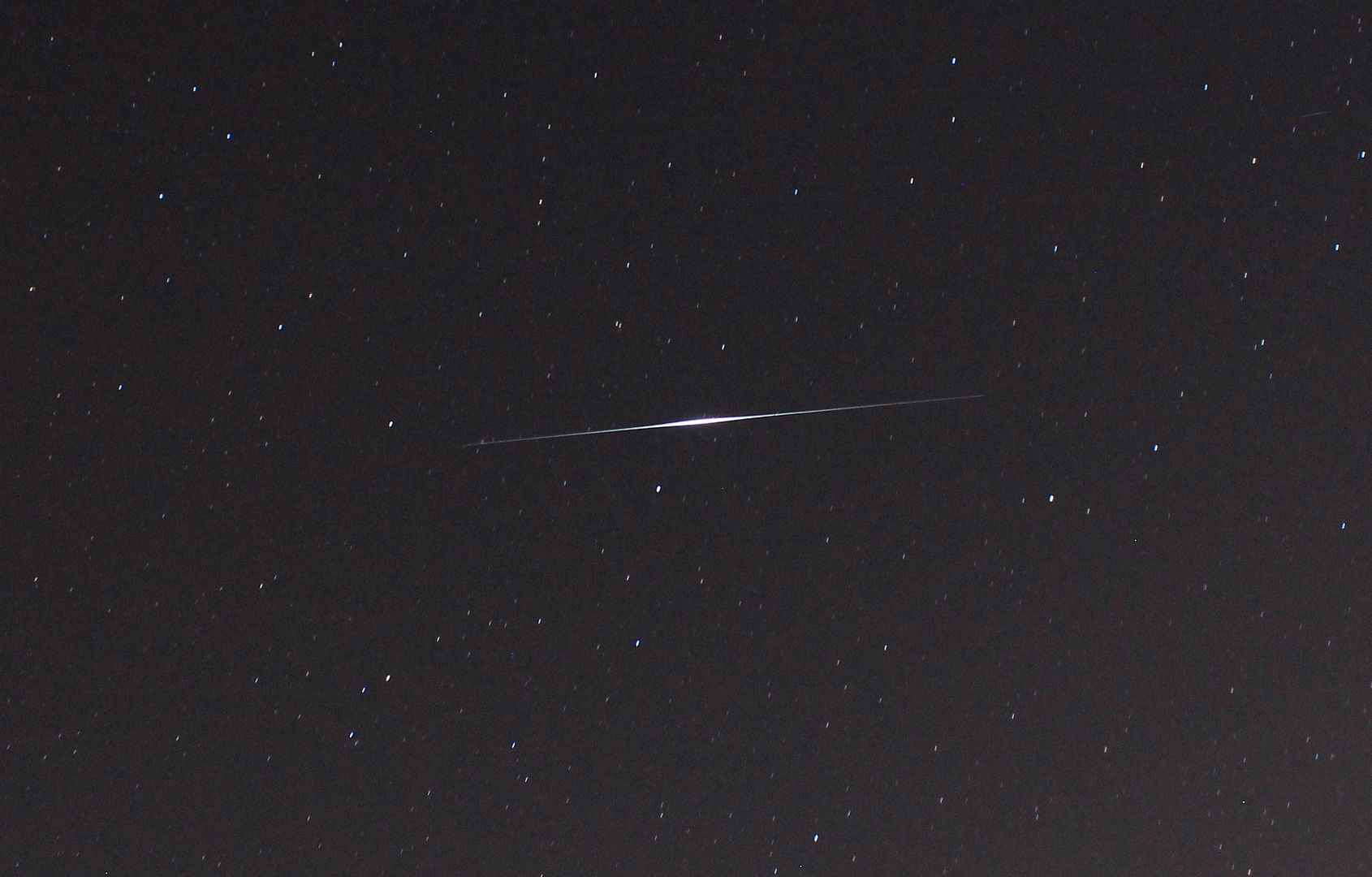 |
| Canon T3i, 18mm, ISO 1600, f/5.6, 30 sec - cropped from the full frame |
I was a mere 2.8 km from the center line, best view of this Iridium flare. If I had set up there it would have been 0.3 magnitudes brighter, not enough to make me move from the convenience of my back yard. The view from there was certainly good enough.
Tuesday, June 3, 2014
Sunset and Space Station
Here is this evening's sunset as seen from my back yard:
Tragically, I caught it after its maximum brilliance, but still, it isn't too bad.
Just like last night, there was a nice passage of the International Space Station in our skies. This one was a little earlier and had a bit more moonlight. Both factors made the sky brighter than last night.
Here are two 30-second long exposures stacked together. That's the bright, over exposed moon at right with the star Regulus above, left of it. The space station was moving up from the bottom (southwest) of the frame toward the top. That's Mars near the very top of the frame, left of center.
Here's a single 30-second exposure of the ISS passing into the northeast part of the sky. The brightest star in the frame is Arcturus.
Tragically, I caught it after its maximum brilliance, but still, it isn't too bad.
Just like last night, there was a nice passage of the International Space Station in our skies. This one was a little earlier and had a bit more moonlight. Both factors made the sky brighter than last night.
Here are two 30-second long exposures stacked together. That's the bright, over exposed moon at right with the star Regulus above, left of it. The space station was moving up from the bottom (southwest) of the frame toward the top. That's Mars near the very top of the frame, left of center.
Here's a single 30-second exposure of the ISS passing into the northeast part of the sky. The brightest star in the frame is Arcturus.
Monday, June 2, 2014
ISS in Our Skies This Week
We just had a nice passage of the International Space Station (ISS). I managed to grab a few pics. There were some cirrus clouds illuminated by the Moon, but I got a couple that I liked.
The trail of the ISS passing to the left of the Moon and Regulus and the backwards question mark of Leo, the Lion.
ISS passing just under the stars of the Big Dipper.
Tomorrow night it will pass even higher in our sky. Look for it in the Tucson area from 8:20 pm till 8:31, with it being at its highest (77 degrees) at 8:25 p.m. Speaking of the space station, if you haven't seen it yet, be sure to check out the live HD streaming video from orbit. It's pretty fantastic.
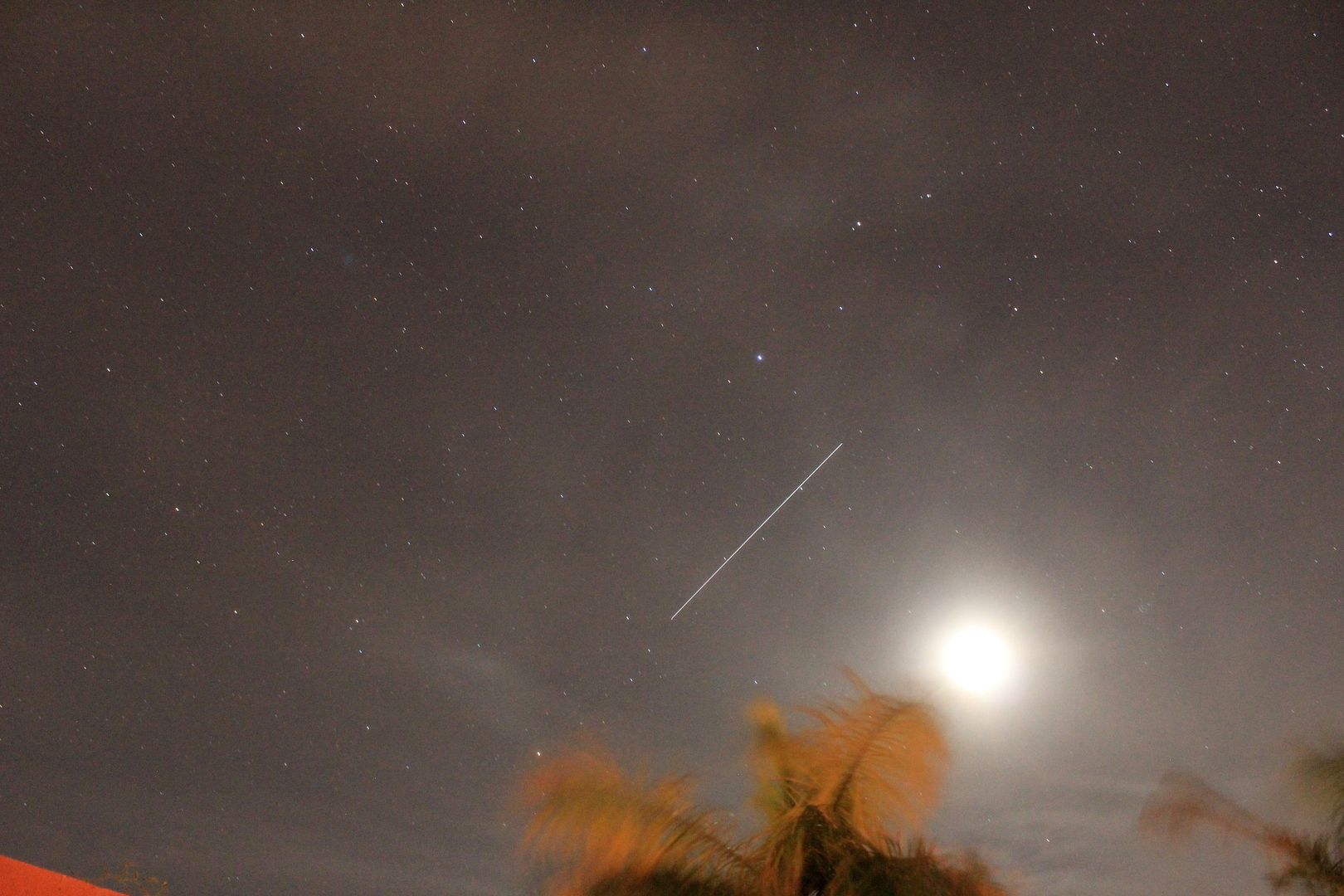 |
| CanonT2i, 30 sec., f/5.6 ISO 3200 |
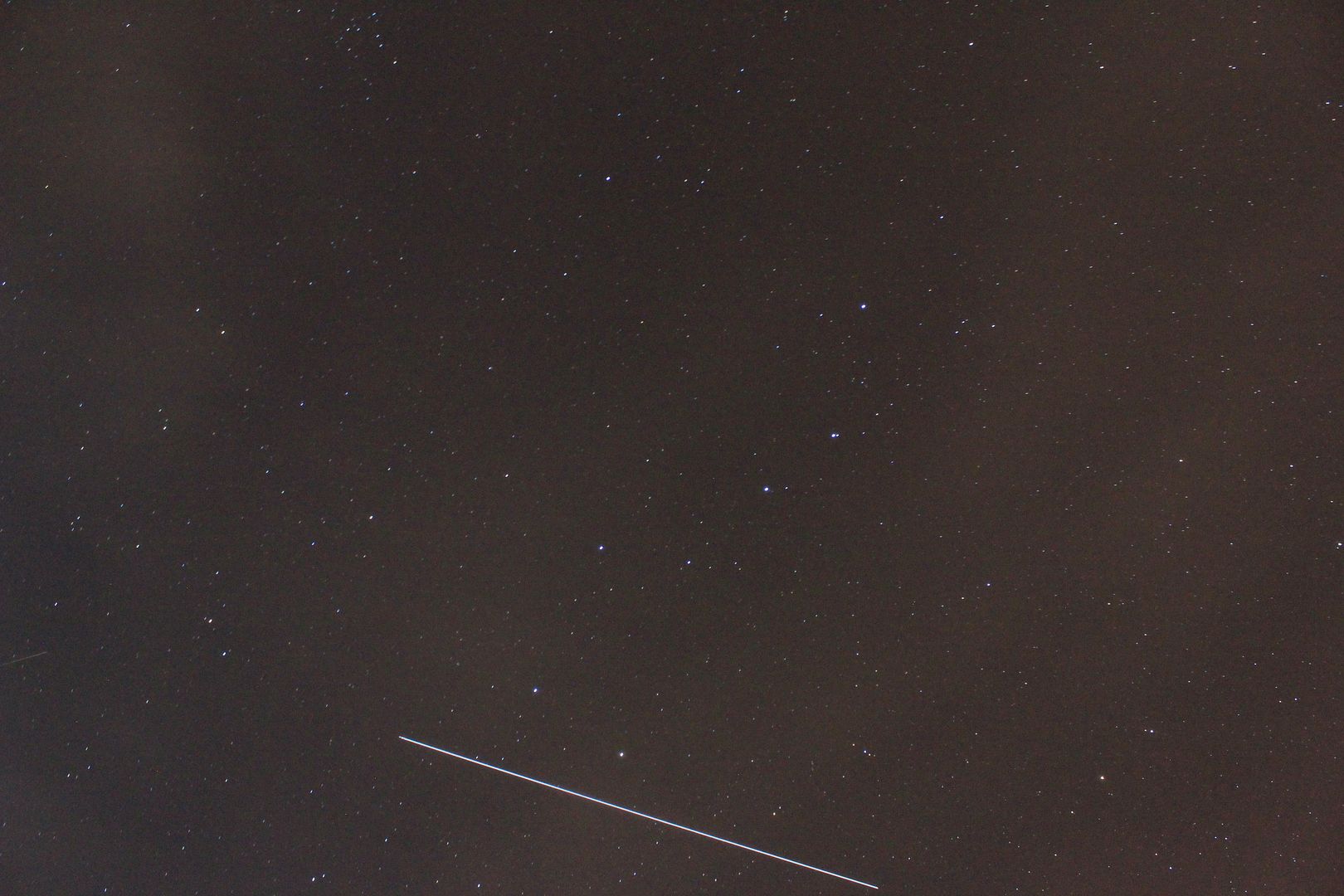 |
| CanonT2i, 30 sec., f/5.6 ISO 3200 |
Tomorrow night it will pass even higher in our sky. Look for it in the Tucson area from 8:20 pm till 8:31, with it being at its highest (77 degrees) at 8:25 p.m. Speaking of the space station, if you haven't seen it yet, be sure to check out the live HD streaming video from orbit. It's pretty fantastic.
Sunday, June 1, 2014
A Shameless Plug and A Sunset
Hey, it's June. That means that the July issue of Sky & Telescope magazine is now out. I've got an article in the issue on light pollution and how cities look from space at night. Here's what the cover looks like (with an oval to highlight my article):
I've been reading S&T since I was around 14, so it is a nice feeling to have an article of my own show up in print. If you get the chance to read it, feel free to let me know what you think. I've blogged here before on the view of cities from space and these posts are the most popular ones on my blog.
Changing the subject, we had a beautiful sunset this evening to kick off the new month. The high level cirrus clouds we shining with a lovely orange glow, making a vivid contrast against the blue sky.
In spite of it being crazy hot in Tucson right now, the was a nice beginning to the month.
I've been reading S&T since I was around 14, so it is a nice feeling to have an article of my own show up in print. If you get the chance to read it, feel free to let me know what you think. I've blogged here before on the view of cities from space and these posts are the most popular ones on my blog.
Changing the subject, we had a beautiful sunset this evening to kick off the new month. The high level cirrus clouds we shining with a lovely orange glow, making a vivid contrast against the blue sky.
In spite of it being crazy hot in Tucson right now, the was a nice beginning to the month.
Subscribe to:
Posts (Atom)





